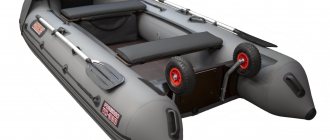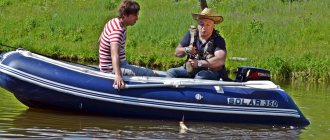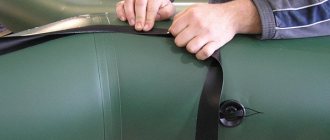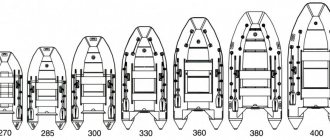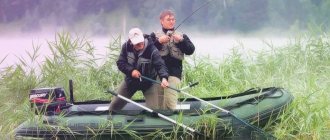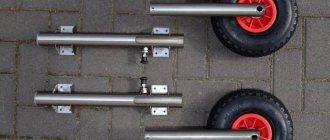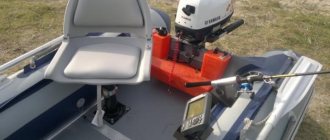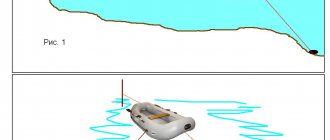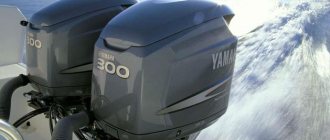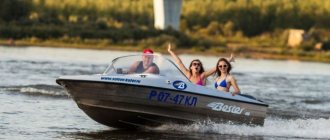Features of fishing from a boat
Fishing from a boat
Ideal fishing, which will bring true pleasure, is possible when the angler does not feel any discomfort while fishing. In order to fish from a boat, the following factors should be considered:
- where to fish (river, lake, reservoir);
- what kind of boat you will be fishing from (size);
- from what depths the fish will be caught;
- Is the body of water familiar to the fisherman?
Having chosen a suitable place for fishing (it is better if there are several such places), you must first install two poles. The poles will perform several functions:
- point to the fishing spot (they should be visible from afar);
- the boat will cling to the poles. If fishing takes place on a river with a noticeable current, then the boat should be positioned across the current. And if you plan to fish on a lake, reservoir or river with a very small current, then the boat can be installed in different ways (along the wind, along the coastline, taking into account the sun, and so on);
- There will be complementary foods on the poles (you can attach a bag to each pole).
In order for the fish to be constantly at the fishing site, it needs to be fed and this must be done constantly, periodically changing and adding new food. In this case, she will, as it were, “graze” in this place, get used to the feeder, and success in good catches will be ensured. At the same time, there is no need to overfeed her, otherwise she will become fat. That is, having fed first, then take breaks for several days so that the fish is on a kind of starvation diet.
But during the fishing itself, you should remember that the bite can change frequently. Therefore, you need to constantly experiment (either remove the complementary food completely, then change the bait on the hooks, then adjust the depth to half-water, and so on). But one rule should always be followed. This rule says that complementary foods should not be more attractive in taste than the bait itself, which is used to attach to hooks. Otherwise, the fish will simply ignore the bait.
Preparation and basic rules
Summer fishing differs from autumn in its hot climate and bite, which is weaker than in autumn. Therefore, for an avid fisherman, autumn is a time of unique excitement and solid catches. And the first thing to remember is the rules of behavior on the water.
For recreational fishing from land, all you need to do is inspect the coastline. When doing boat fishing, you should remember the following rules :
- do not overload the boat and correctly calculate the number of people, each model has its own strictly defined carrying capacity; when the water is rough, the boat may be flooded with water;
- A watercraft that has hull damage and is not equipped with life-saving equipment is a direct threat to your life! Prepare her, do not neglect this advice; if you have a license to operate a small boat, take it with you;
- check the condition of the motor, transom board, oars and their fastenings.
- If you go out in conditions of very limited visibility, be sure to equip your boat with warning lights.
- Do not go out on the water if there is a thunderstorm or strong wind!
Before choosing a fishing spot, check your gear to make sure you haven’t forgotten anything. If you choose a boat, choose a larger vessel. It is much more stable, you can build additional canopies, you can move around the ship without knocking over or turning anything over. Equip the boat with devices with which you can secure your gear. Try to isolate areas where the fishing line or hook might get caught. Take poles (long wooden sticks) with you. You will need them to secure the boat at the fishing spot. Experienced fishermen have several places and stakes already on the water.
Recommendations for fishing from a boat
- A boat for fishing must be stable; it would be better if it is large (so that you can calmly fish, move around it, place gear, a net, a cage and other things, so that you can just relax). It should also be equipped with attachments for fishing rods (so that they can be easily reached and held firmly in the cast position). All sharp corners, protrusions, bolts, oarlocks must be covered with film, tarpaulin or a raincoat (to prevent snagging and tangling of fishing line, net and hooks).
- The most optimal number of fishing rods for fishing is two, maximum three. You can put different baits on fishing rods, then you will be able to catch different fish.
- In shallow water and in still water, the rods should be long, the sinker and float should be small. It is more convenient to fish with long rods from the stern of the boat. This will make it much more convenient to take out fishing rods and lay them along the entire length of the boat towards the bow.
- If fishing takes place at great depths and during currents, then the fishing rods should be short (50-70 centimeters). It will be much easier to pull them out of the water when hooking a fish (after hooking, place the fishing rod next to the boat and continue to pull the fish out by the fishing line). The net should always be at hand.
- When fishing in a current, the boat should be positioned across the current. That is, fishing rods are cast from the side of the boat.
- If you plan to fish on navigable rivers for a long time and it is already dark in the evening, and early in the morning it is not yet dawn, or maybe fog or rain suddenly begins, then in this case you need to take a good flashlight with you. It is needed to provide light signals to ships and boats walking along the fairway. It should be turned on if the sound of an approaching vessel is heard and waved in a circular motion, signaling that people are there.
Fishing in a thunderstorm from a boat
Firstly, when going fishing from a boat, do not forget to take emergency things with you, they can save your life. These are spare things, polyethylene or a good raincoat, it’s good to have a protective awning and so on. If a thunderstorm overtakes you in a boat, immediately approach the shore.
If you cannot do this, then drain the boat and change into dry clothes. Use an awning if available. Place boots, equipment, and a life jacket underneath you.
It is necessary to cover yourself with a film (have it in your boat, just in case) so that it does not touch the water, and rainwater flows overboard and under no circumstances gets inside your boat.
It’s better to check the weather forecast and in case of a possible thunderstorm, it’s better not to fish from a boat.
Advantages of fishing from a boat
Fishing from a boat has advantages over other methods of fishing.
- Mobility, maneuverability.
You can swim from place to place without any problems. This can be very useful when the fish, as they say, don’t bite. All you need to do to swim across is to lift the weight and fishing rods, and you don’t even have to turn around. Agree, this is much easier than carrying all your things on your own back to another place. - Patency.
Even if your boat is rubber, it only seems fragile and is about to break, but in reality you can even swim into the reeds, fix the boat there and fish. Of course, you need to attack the reeds carefully. Even a wooden boat can be broken by force.
When fishing with a spinning rod, you will not be able to climb far into the reeds, you will need high boots, it will be difficult and who knows, there may be a hole where you want to step.
- Accuracy.
When fishing from a boat, you will throw the tackle right next to “that reed” or right next to some cliff. A float from the shore will also take you where you need to go, but only within the shore. From a boat, the distance is not a problem, we'll swim up.
Choosing a place and time for fishing
In order to choose a place and time for planned fishing from a boat, you need to understand which fish is the main object of fishing, know its habitats in the reservoir, and its habits at one time or another of the year. Let's look at examples of fishing for different types of fish in different bodies of water:
- Pike and perch in a lake, channel or oxbow. As a rule, such reservoirs along the banks are densely overgrown with water lilies or other vegetation. Considering that pike is an ambush-type predator, in such a reservoir the main place for its ambushes will be algae and thickets of water lilies. The main time for pike fishing is morning and evening, and in the fall - throughout the daylight hours.
- Pike perch, pike, catfish, bream on a river with a moderate current. The main places for these fish species to stay in the river are bottom irregularities: holes, edges, rifts. To fish a promising place, you need to anchor the boat upstream and throw the bait into promising places. Usually the fish concentrate along the edges of the hole.
Disadvantages of fishing from a boat
- The main disadvantage
is the inconvenience of being in the boat for a long time. At first, everything seems to be fine: you sit, swaying on the waves, everything is nearby, you cast nearby, you don’t look for a place on the shore and you have great freedom of movement. But a few hours pass and the lack of movement or the banal – lack of a toilet – begins to take its toll. It’s good if the boat is wooden, it is more stable than a rubber one. On a hard bottom, if there is no rocking, you can stand for a while and warm up. But still, it’s comfortable to stay on the boat for up to 8 hours maximum. After this time, I really want to go to the shore to stretch my legs, eat, and just walk around. You can’t take a lot of things on board with you; you’ll have to sacrifice some clothing or gear. And this is not always convenient, since you may often need something that was not needed for a long time, and you really don’t want to return to the shore from a baited point. Plus the lack of space and the associated inconveniences. - In case of strong wind, current or its change,
it is not so easy to keep the watercraft in one place. This makes it difficult to observe the bite, and the fishing process itself is not very pleasant, and often simply impossible.
Tips from fishermen
Experienced fishermen advise paying attention to the following points when fishing from a boat:
- when going out on the water, it is necessary to check the boat for possible damage;
- When choosing a fishing location on a reservoir, you must choose a quiet location without shouting nearby on the shore and without the movement of watercraft. The fisherman himself must behave as quietly as possible and make a minimum of movements and maneuvers;
- When going out on the water, it is imperative to follow safety precautions and wear a special vest. You cannot place a boat for fishing on the fairway, where the movement of river craft is possible;
- When fishing from a boat, it is imperative that the fisherman have a landing net or hook for convenient removal of fish from the hook, as well as a kukan or cage for storing the caught fish.
Fishing from a boat significantly increases the angler’s chances of a big catch, because it allows him to reach any point in the reservoir. And, taking into account the capabilities of modern gear and echo sounder, the problem of finding and catching fish is greatly simplified.
Choosing a fishing boat
A huge number of open water fishing enthusiasts begin to get acquainted with fishing by purchasing inflatable boats.
Rubber boats for fishing, for example, are very compact and easy to transport in personal transport. In addition, today inflatable boats made for engines have also gained significant popularity. Because they can be used both as rowing boats and as motor boats. Boats
Inflatable boats for fishing do not necessarily have to be of significant size. For single fishing in small bodies of water, an inflatable boat 1.85-3.45 meters long will be sufficient. It is not heavy, compact and will not cause inconvenience during transportation. If a joint vacation is planned, then inflatable boats with a length of 3.45 - 3.55 meters and up to 3.85 meters will be needed. It all depends on the style of fishing you intend to do. If a fisherman mainly fishes on a lake near the shore and cannot afford to buy a PVC boat, then the most appropriate solution would be to use a regular rubber boat. In order for it to serve for a long time, it needs proper storage conditions. The disadvantage of such a boat is the lack of a strong bottom.
Boat fishing gear
Gear for fishing from a boat Three types of gear are usually used for fishing in currents from a boat.
If the depth does not exceed 5-6 m, classic wiring is traditionally used with the line being released from the boat. The tackle is a wire rod with a length of 3 to 6 m, equipped with guide rings, a reel seat, and a reel with a supply of fishing line. If the fishing depth does not exceed the length of the rod, then equipment with stationary floats is used, otherwise sliding floats are used. In both cases, floats with one fishing line attachment point are preferable. For successful fishing you need to find either a “table” or the upper edge of the riverbed. After the boat is anchored, bait is lowered into the water either in the form of balls or in a heavy feeder. The feeder is usually designed for five to six kilograms of bait. The same baits are used as bait as when fishing from the shore, but still, a worm and maggot, as well as a “sandwich” of them, are more often used. When fishing from great depths (up to 12 m), sliding equipment is effective only on a flat and fairly weak current, for example, on deep irrigation of the Volga reservoirs.
In places where great depths are combined with strong currents, the use of so-called side fishing rods is very common. Side fishing rods can be divided into two design options. The first option is a long winter fishing rod for vertical lure fishing. A fishing rod can be equipped with a reel or reel, onto which fishermen wind a fairly thick fishing line, sometimes with a diameter of up to 0.3 mm. A hook or jig equipped with a powerful hook is tied to the end of the fishing line. There is a sinker above the hook, and there is often no catch at all. They try to choose a jig of such a size that no additional sinker is required. A long (up to half a meter) guard made of wire or metal plate is mounted at the end of the fishing rod. The gear is very rough, but if you know exactly where the large fish are located and you know what is good for fishing, then the result can be very good. What’s bad about this kind of gear is that it’s good for fishing in calm and calm weather, on a flat current, when ships and boats are not yet navigating the river. When there is excitement on the river, the bait, rigidly connected to the guard, is in constant, chaotic movement, and large fish do not really like this. What can you recommend if you do fish in conditions of quite strong waves? First, use long guards made of a flat metal spring, which will bend strongly under the influence of the current. Secondly, increase the distance between the hook and the sinker to one and a half to two meters. Thirdly, place a small (0.5 g) feed on the fishing line at a distance of approximately 30-40 cm above the hook. But by increasing the length of the leash, you automatically move the hooks with bait away from the bait, and this sharply reduces the number of bites. The bait definitely has to be placed in the feeder. Recently, instead of a fishing rod with a metal guard, short rods with a soft tip (pickers) have been successfully used. Replaceable tips of different hardness allow you to adjust the tackle to the current and depth.
In the event that the fishing depth is large and the current is strong enough, it is better to use gear in which the feeder is combined with a sinker. Practice shows that the closer the bait is to the groundbait, the more active the bite.
There are two common rig options here. The classic rig consists of a thick (0.35-0.50 mm) fishing line, at the end of which two short (10-15 cm) leashes are tied. The sinker is a figure eight made of thick metal. The inner diameter of a small figure eight ring can be from one to three millimeters, and the diameter of a large ring can be several centimeters. In the circumference of the large ring there is an angular slot, like on a cut. A thick (1-1.5 mm) fishing line or rope is inserted into this slot, at the end of which a feeder is attached. A stopper is attached to the fishing line with leashes at a distance of approximately 30-50 cm from the hooks. The fishing technique is very simple and effective. First, a feeder filled with bait is lowered to the bottom on a rope. Then the rope from the feeder is wound into a large ring and the figure eight is lowered to the feeder. Such equipment was at one time called “ringing”.
Preparing the gear
Usually, for fishing from a boat, shorter rods are used, which will increase mobility inside the shuttle.
It is most convenient to use spinning rods with a length of 2.10 m.
The test component of the rod will depend on the weights of the baits that are planned to be used in spinning fishing or the weight of the sinker of the bottom tackle.
Here are the main types of equipment that you may need:
- When fishing for pike and perch in lake-type reservoirs, the optimal spinning rod with a fast action, weight up to 20 grams and a length of 2.10 m will be optimal. The tackle is equipped with a spinning reel of size 2000 and 0.1-0.15 mm braid. Using a leash against pike teeth is mandatory. This equipment will allow you to use a very wide range of baits: wobblers, various spinners, jig baits.
- When catching predators on the river from a boat, a rod with high test characteristics is used. Their size will depend on the speed of the flow and the depth of the river. The standard test for a deep river with moderate current would be a test up to 40 grams. The spinning tackle is equipped with a spinning reel of size 3000 and 0.13-0.2 mm braid. With such gear you can successfully fish with jigs in deep river holes using silicone baits.
- When catching white river fish from a boat, a feeder rod 2.1-2.4 meters long and about 100 grams of dough is used. The tackle is equipped with a 3000 reel and 0.15-0.2 mm braid.
The equipment can be different, but the equipment with an anti-twist is considered the most universal. To make a leash, fluorocarbon fishing line with a diameter of 0.18-0.2 mm and a hook No. 6-8 are used. The main objects for fishing with such gear will be bream and silver bream.
Security measures
:Safety measures when fishing from a boat In the summer, happy owners of swimming equipment prefer to fish from a boat. Therefore, the issue of safety for these people is quite acute; following certain rules will not only help you avoid trouble while fishing, but even save your life.
- Let's start with the fact that when driving a boat, be very careful; even on a familiar body of water, there may be submerged logs, remains of old trees and bushes in the water.
- If you are fishing on a rubber boat, then be extremely careful, do not swim close to bushes and trees sticking out of the water, you can run into branches.
- Look carefully ahead when you are motoring, or even better, place a friend on the bow of the boat. At least it will signal you with established signals about any obstacle on the water, and tell you how to go around it.
- There may be underwater rocks on rivers and some lakes; certainly on taiga rivers and old northern lakes. In this case, it is better to use the services of local guides and fish on local boats, which are designed to pass rapids and are not afraid of underwater boulders.
- When fishing in an unfamiliar body of water, try to avoid swimming and especially without diving into the water. You don't know the bottom. You don’t know where, what snags and boulders may be located. Perhaps the bottom is heavily silted and sucks in instantly. Or perhaps at the bottom there is old construction waste with an abundance of iron structures and fittings.
- Even if you are hooked on a very expensive float tackle or spoon, do not get into the water. Everything you have in your hands is a consumable item, and you will buy more, but you only have one life. Remember: not a single one of yours, even the most expensive spoon, is worth a small cut on your heel, and as a result of this, ruined fishing, or worse, some kind of infection such as tetanus.
- It is very dangerous to go fishing on an old, leaky boat. If you don’t have any other means of swimming, but you really want to, then don’t swim far from the shore and have a water scoop with you.
- Do not lean on the side of the boat when fishing for fish or removing an anchor that is heavily embedded in the mud. You could lose your balance and easily end up in the water or scoop up water on the side of the boat.
- On the water, do not position the boat with its side facing gusty winds or along the waves. If the sides of your boat are not large, then the next wave may overwhelm and drown your boat.
- If there is a squally wind and a wave on the reservoir, do not take risks, swim out urgently. It will definitely rain soon, and perhaps there will be a thunderstorm. It is unknown how all this may end for your swimming device and, of course, for you. It is better to swim across the waves, even if further and not to the destination, but such a movement of the vessel is safer. Remember, it’s okay if you walk a few kilometers along the shore, it’s better than sinking the boat and having to swim yourself out of plan. And it’s easier later to move the boat to the right place in calm weather than now to get there by swimming on your own in terrible weather, but where you need to go.
- When choosing a place to fish on a large navigable river, pay attention to buoys, buoys and directional marks. Do not fish on the shipping route or main waterway. Remember that in deep water you need to be careful. And don't swim behind the buoys.
- If you do not know how to swim, then do not sail the boat far from the shore, and be sure to purchase a life jacket. All your comrades must know that you cannot swim. If, after all, the boat capsizes and you find yourself in the water, then do not try to climb into the boat, but, holding onto it tightly, try to swim to the shore. If you see that there are fishermen on boats at some distance, then do not be shy and call for help, or at least just shout. They will definitely help you.
- When fishing from a boat, do not forget to put an inflated balloon in your backpack with unused items or tie it to your backpack. Anything can happen. But your belongings and life support supplies will always remain afloat during camping conditions, and will not go under water or get lost.
- If you plan to fish on a large lake or bay, be sure to check the weather forecast. And always have with you a life jacket, a signal light, a signal cartridge or flare, a tow rope, a compass, a supply of high-calorie foods, a mobile phone or a radio station. And don't take risks if a storm warning is issued.
If the boat capsized
If suddenly the boat capsizes at a considerable distance from the shore and at great depth, then first it will lie on its side, and then turn over with its keel up. If there is no one nearby who can provide assistance, then, grabbing the stern or bow of the craft, paddling with your feet, swim to a shallow place or to the nearest shore. Never try to climb onto an overturned boat, as it will often capsize. Therefore, there is a risk that the boat will hit or cover the fisherman when doing so. If the boat capsizes on a river riffle or in a strong current, then you need to hold on to the boat and swim after it to a shallow place.
Catching peaceful fish from a boat.
We are back in Sorokoshichi!
Now summer is in full swing. Heat! Fishing from a boat seems like a pleasant pleasure only in the morning, while it is still cool. And by noon, this event is more like frying... So, everything needs to be done before the midday heat!
This time the guest of our program is Alexey.
Alexey and I have known each other for a long time. This spring we met at a fishing and hunting exhibition. By the way, our specialized exhibition, so to speak, has long turned into a flea market. But personally, our circle of fans, in principle, does not buy anything at the exhibition, but visits it exclusively to communicate with like-minded people. Well, look at the new items. Alexey also offered something new at the exhibition.
Moreover, these were not gear, but our, domestic shoes
. Shoes for active recreation!
Became interesting. The shoes looked very good. What about in practice? Later it turned out great! That’s where we began our communication, which gradually grew from formal to informal. Where do we communicate informally? Well, of course, fishing! And therefore, the natural result of our acquaintance was our fishing trips. This time we decided to catch white fish. The peak of the catfish bite has already passed. The pike perch is not responding very well so far. The time for pike has not yet come. It's time to tune in to the dice, especially since spring supplies are already running out. And the frying pans are already missing the bream ribs.
Our friend is an advanced level fisherman. With a good speed boat. With good gear. But mostly he loves fishing for predators. He rarely goes fishing for white fish, and at the same time he always thought that it was very difficult and painstaking fishing. You need to buy a lot of expensive bait, a sieve, etc. Knit thin, ingenious cordage. It takes a long time to feed... Therefore, when he saw my bag of crackers, a bucket of barley porridge, some peas and just a pack of inexpensive domestic bait “G.STREAM” “fast river”, I got a little worried.
He was horrified by the hefty hooks No. 6 and thick 0.25 leashes... However, thank God, Alexey is a brave and determined man, not afraid of extreme sports. (I think that organizing the production of shoes in our country requires more courage!). And therefore, I still accepted my rules of playing the game, or rather fishing. Although, I must say, he put on the old feeding trough - “shanka” with great distrust. With a great deal of skepticism, I looked at the exotic “Podolsk fork” I saw for the first time - the legendary system of knitting leashes from old Kyiv fishermen.
We used white and red worms for bait. Attractants from “G.STREAM” were also used - honey, caramel, hemp. Now in the summer, with warm water, they really make a difference.
There was light rain in the morning and, waiting for it, we slightly delayed our departure. Therefore, they anchored not at dawn, but at about seven in the morning.
The bites did not take long to arrive. The usual undergrowth was the first to bite, and quite quickly, and this generally gave us hope that we had successfully entered its passage path. Then came the large red fairway or, as it is also called here, the “Trinity” silver bream.
On the one hand, given that there is practically no ram at home, and the football season is still ahead, the bream was very suitable for us.
But you also need bream! How is it possible to not catch a bream...
However, Gustera prevailed! The red-winged fish walked in doublets and didn’t care about the large size of the hooks - it took it greedily, deep into its throat!
From time to time, a small underbream and some good bluefish made their way through... There was a moment when we thought about changing the place and looking for bream. But the consequences of summing up the results of yesterday's football match made themselves felt and therefore, we decided not to create unnecessary stress for ourselves, not to turn fishing into a gorbilovka, but to stupidly stand at one anchor and hope. And our hopes were justified! The bream came, after all, we fed it!
He arrived in the classic way, in the second hour of fishing. Unfortunately, the most common one is the kilogram one. There was a big red and white sandwich, heavily flavored with the attractant “G.STREAM” caramel. He pecked for about an hour, during which time the quota for him was fulfilled. Alexey was really pleasantly surprised when he realized how, with such a minimalist approach to fishing, you can catch fish quite successfully and without any problems.
Then a cloud came over and it began to rain. The pressure went down and apparently quite sharply. This did not frighten the silver bream and the small undergrowth and they continued to peck. But the big bream left. However, by that time the fish supply was already just under the old norm and therefore the foolish experiments began. The most striking of which was an attempt to fish on an old “pillow” type feeder. It was received as a gift last year. My Chernigov friends gave it to me. The last time I used this feeder was thirty years ago, maybe more. What to say! The veteran feeder can still be relevant and quite functional, if we proceed from the saying “an old horse will not spoil the furrow, but it will not plow it deep.”
During the afternoon it became terribly soaring. Leaden clouds appeared on the horizon. As it turned out later, a hurricane was heading towards us. But I met him already at home, watching the popular TV show “fishing in the style of old fish” on TV TROPHY!
After a contrast shower and a plate of peaches, with a glass of soothing homemade attractant, carefully served by my wife in bed. I always said that a sense of proportion is never a hindrance in fishing!

